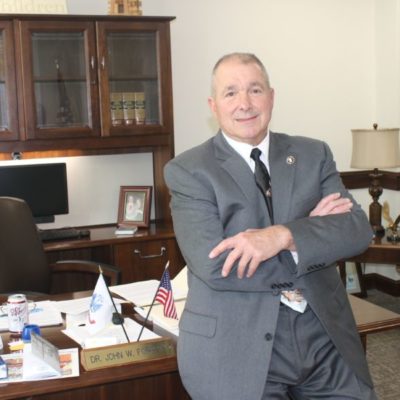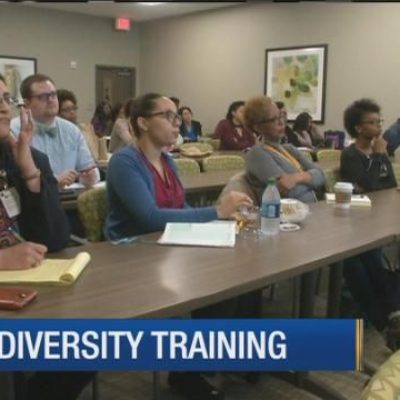Food Pantries Help Food-Insecure Students Breathe a Sigh of Relief
Twenty-eight of the 427 students at Two Rivers Middle Prep are experiencing homelessness. Nearly 90 percent of the student body is classified as economically disadvantaged.
Two Rivers is a part of what’s known as the McGavock cluster, which includes 16 other schools. Of the group, Two Rivers has the largest in-school food pantry, and it serves as a food distribution point for low-income members of the community. Food pantries are often agencies of larger food banks — the site at Two Rivers, for example, is supported by Second Harvest of Middle Tennessee.
Community Achieves is a Metro Nashville Public Schools initiative. At Two Rivers, it is site manager Nicole Valentine’s job to coordinate partnerships that personalize learning for students and engage the community and parents. For some of those students, personalized learning means addressing food insecurity.
“There are only two schools within the cluster that have a Community Achieves site manager,” says Valentine, “and that means neighboring schools depend on the support of schools that have a pantry.”
More than 80 percent of students at Two Rivers are bused in from neighborhoods like the Napier public housing community and the apartment complexes along Elm Hill Pike. Valentine says 65 percent of those attending the school are students of color.
“We have students whose families have a place of their own, students that live in a shelter, students that are living in a motel,” says Valentine. “Last school year, there were a couple of families living in the campsite near Opryland.”
Shelly Dunaway, Two Rivers’ principal, says that each month, the in-school food pantry serves anywhere from 80 to 100 students through Community Achieves.
“With our homelessness rate and our students who live in poverty, we want to provide those wraparound services, and we know students who are hungry can’t focus,” says Dunaway. “Their mind is on lunch time, on what’s being served, and we really want to provide our students that safe environment where their focus can be on school. A part of that is providing them with nutritional foods on the weekends, holidays and in the evenings.
“We remained a school that is eligible for free and reduced lunch, but we are 83 percent poverty at the school,” she continues. “That covers most of our kids. We know they eat breakfast and lunch here, but I always worry about whether they are getting meals when we leave.”
The nonprofit hunger-relief group Feeding America reports that on average, 22 million students in the U.S. receive free and reduced-price lunches each year through federal programs. But once the bell sounds and students are sent home, their nutritional needs often go unaddressed. Food pantries like the one at Two Rivers help address those needs — and it isn’t the only school that has faced more issues than federal programs can address.
Last fall, Jennifer Rheinecker and a colleague at Donelson Middle School overheard some students talking about how they wouldn’t have food to eat over the weekend. By the next week, teachers at Donelson Middle had started bringing in nonperishable food items that the students could take home in their backpacks. Pretty soon, there was so much food for students that a dedicated space in the school was allotted. Now there’s a permanent food pantry at Donelson Middle School, where students can get the food they’ll need from Friday afternoon to Sunday evening.
Dawn Rutledge, MNPS spokesperson, says schools in the district put together food pantries on the basis of the individual needs of the student body.
“We have several schools that do food pantries that allow people to bring in food donations for students and families,” Rutledge says. “That’s something individual schools have tackled, and each school kind of decides how that works. We still have quite a number of students that need to have that support, and that’s always going to be something we have to look at.”
In Davidson County, 80,000 residents depend on SNAP and other nutritional-assistance programs, and federal initiatives like the Community Eligibility Program help address some of the nutritional-assistance needs, but even with in-school programs like CEP and the Backpack Program (through Feeding America), Rheinecker says there are still gaps that need filling.
“Those programs help, but that still leaves big gaps during non-school hours,” she says. “And we know students who are hungry can’t learn — children listening to rumbling stomachs can’t hear anything else that happens in school. We have food drives a few times a year, and teachers and staff supplement with needed items too. The pantry is available for any student who says they need food, and if we have an extended break ahead or anticipate possible snow days, we always give them extra.”
Rheinecker says now, a year after the Donelson Middle pantry was created, the administration is seeing about 15 students use the pantry each week. By the end of the year, they expect that number to have quadrupled.
Rosemary Hunter, assistant professor of pediatrics at Vanderbilt University, says Rheinecker’s sentiments are supported by research — the stress that comes from not knowing where your next meal is coming from is overwhelming to young people, and often has lasting effects.
“[Food-insecure students] have been shown to have symptoms of depression and anxiety, and behavior problems do increase as their food insecurity increases,” Hunter says. “So much of what happens is in a group setting, so they need to be able to be engaged and participate and cooperate with their peers. [Studies] have shown that children who are hungry have limitations in skill acquisition compared to children that are food secure. It ends up holding them back over time.”
For Dunaway and others managing the food pantries, that hits close to home.
“My husband and I raised four boys, and now I have four school-age grandchildren,” says Dunaway. “We are blessed that there is food on our table, but when I sit down with my family and we’re about to enjoy a meal together and we are saying the blessing, I think about my kids here at Two Rivers. I wonder about if they’re OK. Everybody in this building is working to help these kids have what they need to be successful at school — when they walk in the door, we don’t want them to be worried about how they don’t have a coat or a meal for dinner.
“We want them to be able to come to school, breathe a sigh of relief if they need to, and know they’re in a caring environment where they can just do what they need to do as students.”
[Read more at the Nashville Scene]


